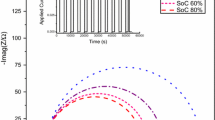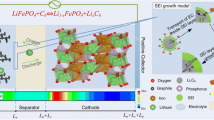Abstract
We have developed a new method to describe a fading model integrated with a parasitic reaction of rechargeable Li-ion batteries in the present work. In our work, the Li-ion battery reactions and the parasitic reaction are incorporated into one model. A new governing equation and a new field variable are presented in the new model to characterize the parasitic reaction and the relationship to the battery fading. Due to the new variations, the parameters that are changed with the battery’s aging are able to be calculated and updated automatically in the model. The parasitic reaction is assumed to obey a Tafel equation. The simulating results show that the distribution of overpotential of the parasitic reaction as function of x shapes, a figure close to a “V,” suggests the nonuniform distribution of the parasitic current. The parasitic reaction’s equilibrium potential is proved to be one of most important factors that determine the rate of the reaction. In addition, the cutoff charging state of charge (SOC) has a large influence on the parameters related to the rate of the parasitic reaction. Therefore, controlling the charging SOC can be seen as an effective method to protect the battery from aging.










Similar content being viewed by others
Abbreviations
- S a :
-
Specific interfacial area of porous electrode (m2 m−3)
- c :
-
Lithium concentration (mol m−3)
- D :
-
Diffusion coefficient
- F :
-
Faraday’s constant (96,487 C mol−1)
- i :
-
Current density (A m−2)
- i 0 :
-
Exchange current density (A m−2)
- I :
-
Current (A)
- k :
-
Rate constant to lithium intercalation/deintercalation (Am2.5 C−1 mol−0.5)
- M :
-
Molecular weight (kg mol−1)
- Q loss :
-
Volume-averaged capacity lost due to parasitic reaction (C m−3)
- r :
-
Radius of particles (m)
- R :
-
Universal gas constant (8.314 J mol−1 K−1)
- R film :
-
Film resistance at the anode (Ω m2)
- S :
-
Geometric surface area of electrode (m2)
- SOC :
-
State of charge
- t :
-
Time (s)
- T :
-
Temperature (K)
- E :
-
Local potential (V)
- V :
-
Battery output voltage (V)
- L :
-
Length (m)
- β :
-
Anodic transfer coefficient of an electrochemical reaction
- α :
-
Cathodic transfer coefficient of an electrochemical reaction
- ε :
-
Volume fraction of a phase
- φ :
-
Potential of a phase (V)
- η :
-
Overpotential of an electrochemical reaction (V)
- κ :
-
Conductivity of a phase (S m−1)
- ρ :
-
Density of film (kg m−3)
- e:
-
Electrolyte phase
- eff:
-
Effective
- i :
-
Positive or negative electrode
- Li:
-
Li-ion intercalation/deintercalation
- m:
-
Membrane separator
- max:
-
Maximum value
- N:
-
Cycle number
- n:
-
Negative
- p:
-
Positive electrode
- film:
-
SEI film or SEI film reaction
- grow:
-
Increased length of SEI film
- ref:
-
In reference to Li+/Li electrode
- s:
-
Solid/electrolyte interface
- s/e:
-
Solid/electrolyte interface
- 0:
-
Initial state
- con:
-
Consumed by the parasitic reaction
- y :
-
Stoichiometric number of lithium ion
- x :
-
Intercalation/deintercalation stoichiometric number of lithium ion
References
Marcicki J, Conliska AT, Rizzoni G (2012) ECS Trans 41:9–21
Ramadesigan V, Chen KJ, Burns NA (2011) J Electrochem Soc 158:A1048–A1054
Hibino M, Nakamura M, Kamitaka Y (2006) Solid State Ionics 177:2653–2656
Wang Z, Huang Y, Wang X (2013) Solid State Ionics 232:19–23
Liu P, Wang J, Hicks-Garner J (2010) J Electrochem Soc 157:A499–A507
Fu LJ, Endo K, Sekine K (2006) J Power Sources 162:663–666
Zhao S, Bai Y, Ding L (2013) Solid State Ionics 247–248:22–29
Ramadass P, Haran B, White R (2003) J Power Sources 123:230–240
Aurbach D (2000) J Power Sources 89:206–218
Aurbach D, Markovsky B, Rodkin A (2002) Electrochim Acta 47:1899–1911
Aurbach D, Zinigrad E, Cohen Y (2002) Solid State Ionics 148:405–416
Ramadass P, Haran B, Gomadam PM (2004) J Electrochem Soc 151:A196–A203
Ploehn HJ, Ramadass P, White RE (2004) J Electrochem Soc 151:A456–A462
Safari M, Morcrette M, Teyssot A (2009) J Electrochem Soc 156:A145–A153
Safari M, Morcrette M, Teyssot A (2010) J Electrochem Soc 157:A892–A898
Safari M, Delacourt C (2011) J Electrochem Soc 158:A1123–A1135
Safari M, Delacourt C (2011) J Electrochem Soc 158:A1436–A1447
Vazquez-Arenas J, Fowler M, Mao XF (2012) J Power Sources 215:28–35
Ning G, Popov BN (2004) J Electrochem Soc 151:A1584–A1591
Ning G, White RE, Popov BN (2006) Electrochim Acta 51:2012–2022
Arora P, White RE, Doyle M (1998) J Electrochem Soc 145(10):3647–3667
Nyman A, Zavalis TG, Elger R (2010) J Electrochem Soc 157:A1236–A1246
Sikha G, Popov BN, White RE (2004) J Electrochem Soc 15:A1104–A1114
Christensen J, Newman J (2004) J Electrochem Soc 151:A1977–A1988
Doyle M, Fuller TF, Newman J (1993) J Electrochem Soc 140:1526–1533
Doyle M, Newman J, Gozdz AS (1996) J Electrochem Soc 143:1890–1903
Bard AJ, Faulkner LR (2001) Electrochemical methods—fundamentals and applications, 3rd edn. Wiley, New York
Smith K, Wang C-Y (2006) J Power Sources 16:628–639
Li SY, Xu XL, Shi XM (2012) J Power Sources 217:503–508
Eshkenazi V, Peled E, Burstein L, Golodnitsky D (2004) Solid State Ionics 170:83–91
Aurbach D, Levi M, Levi E (1997) J Phys Chem B 101:2195–2206
Verma P, Maire P, Novak P (2010) Electrochim Acta 55:6332–6341
Shi S, Lu P, Liu Z (2012) J Am Chem Soc 134:15476–15487
Bhattacharya S, Alpas AT (2012) Carbon 50:5359–5371
Acknowledgements
This work was supported by the National Natural Science Foundation of China (NSFC) under the grant number of 51106115 and the Fundamental Research Funds for the Central Universities under the grant number of WUT: 2014-IV-119.
Author information
Authors and Affiliations
Corresponding author
Rights and permissions
About this article
Cite this article
Kang, J., Conlisk, A.T. & Rizzoni, G. Integration of capacity fading in an electrochemical model of Li-ion batteries. J Solid State Electrochem 18, 2425–2434 (2014). https://doi.org/10.1007/s10008-014-2479-y
Received:
Revised:
Accepted:
Published:
Issue Date:
DOI: https://doi.org/10.1007/s10008-014-2479-y




